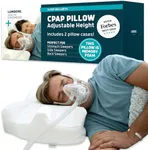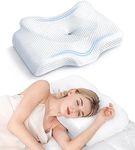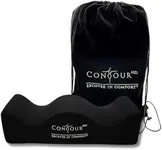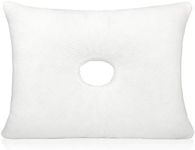Buying Guide for the Best Cpap Pillow
Choosing the right CPAP pillow is crucial for ensuring a comfortable and effective sleep therapy experience. CPAP pillows are specially designed to accommodate the mask and hose of a CPAP machine, which is used to treat sleep apnea. The right pillow can help reduce mask leaks, improve comfort, and support proper alignment of the head, neck, and spine. When selecting a CPAP pillow, consider the following key specifications to find the best fit for your needs.MaterialThe material of a CPAP pillow affects its comfort, support, and durability. Common materials include memory foam, which contours to your head and neck for personalized support, and fiberfill, which offers a softer, more traditional pillow feel. Memory foam is ideal for those who need extra support and pressure relief, while fiberfill is better for those who prefer a softer, more cushioned surface. Consider your personal comfort preferences and any allergies when choosing the material.
Shape and DesignCPAP pillows come in various shapes and designs to accommodate different sleeping positions and mask types. Some have cutouts or contours to reduce pressure on the mask and prevent leaks. Others are designed to support side, back, or stomach sleepers specifically. If you primarily sleep on your side, look for a pillow with side cutouts. For back sleepers, a pillow with a central contour can help maintain proper alignment. Stomach sleepers may benefit from a thinner, more flexible pillow.
SizeThe size of the CPAP pillow should match your body size and sleeping habits. Standard, queen, and king sizes are available, with larger sizes providing more surface area for movement during sleep. A larger pillow may be beneficial if you tend to move around a lot, while a smaller pillow can be more manageable and easier to position. Consider your bed size and how much space you need to sleep comfortably when choosing the pillow size.
Height/LoftThe height or loft of a CPAP pillow refers to its thickness. A higher loft provides more elevation and support, which can be beneficial for back sleepers or those with broader shoulders. A lower loft is better for stomach sleepers or those who prefer a flatter pillow. Side sleepers may need a medium loft to keep their head and neck aligned. Consider your sleeping position and any neck or shoulder issues when selecting the loft of your pillow.
Mask CompatibilityEnsure that the CPAP pillow you choose is compatible with your specific CPAP mask type. Some pillows are designed with specific mask styles in mind, such as nasal masks, full-face masks, or nasal pillow masks. Compatibility is important to prevent mask displacement and leaks, which can disrupt your sleep therapy. Check the pillow's design and features to ensure it will work well with your mask.
Hypoallergenic PropertiesIf you have allergies or sensitivities, look for a CPAP pillow with hypoallergenic properties. These pillows are made from materials that resist allergens like dust mites, mold, and pet dander. Hypoallergenic pillows can help reduce allergy symptoms and improve overall sleep quality. Consider your allergy history and any specific sensitivities when choosing a pillow with hypoallergenic features.
Ease of CleaningRegular cleaning of your CPAP pillow is important for maintaining hygiene and prolonging its lifespan. Some pillows come with removable, machine-washable covers, while others may require spot cleaning. A pillow with a washable cover is more convenient and easier to keep clean. Consider how much time and effort you are willing to invest in maintaining your pillow when making your choice.
















